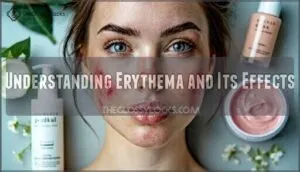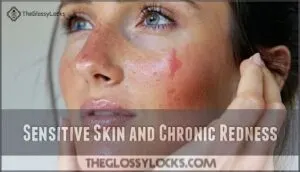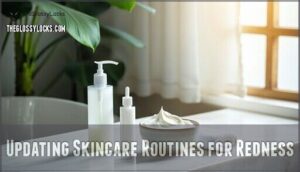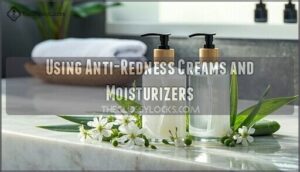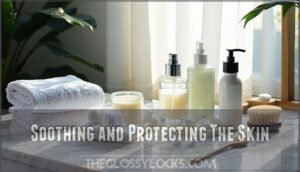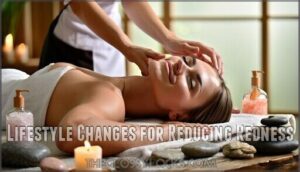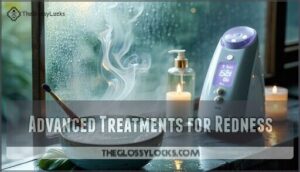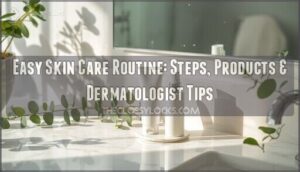This site is supported by our readers. We may earn a commission, at no cost to you, if you purchase through links.
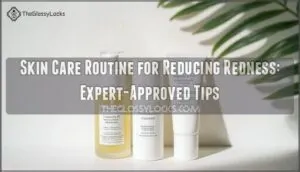
Follow up with a moisturizer containing ceramides or niacinamide to calm inflammation and strengthen your skin’s defenses. Don’t skip sunscreen; UV exposure is like throwing gasoline on a fire when you’re dealing with redness.
The key is consistency and patience—your skin didn’t get irritated overnight, and it won’t heal that quickly either. Think of these gentle ingredients as your skin’s personal bodyguards, working around the clock to keep irritation at bay.
Table Of Contents
- Key Takeaways
- Causes of Skin Redness
- Managing Skin Redness
- Soothing and Protecting The Skin
- Rosacea Overview and Management
- Top 10 Products for Reducing Redness
- 1. Hydrating Facial Cleanser for Dry Skin
- 2. Fragrance Free Dove Beauty Bar Soap
- 3. Vanicream Sensitive Skin Moisturizer
- 4. Avne Antirougeurs Soothing Face Mask
- 5. No7 Cica Rescue Skin Paste
- 6. Colorescience Redness Corrector with SPF
- 7. EltaMD UV Clear Face Sunscreen
- 8. Jan Marini RosaLieve Redness Reducer
- 9. Paula’s Choice Azelaic Acid Booster
- 10. Melatonin Night Serum Anti Aging
- Creating a Personalized Skincare Routine
- Lifestyle Changes for Reducing Redness
- Sun Protection and Redness
- Advanced Treatments for Redness
- Frequently Asked Questions (FAQs)
- How to reduce redness in skin care?
- What skincare reduces redness?
- What skin treatments reduce redness?
- How do you fade redness on skin?
- What is the best skin procedure for redness?
- How long does it take to see results?
- Can diet affect skin redness?
- Are there any natural remedies for skin redness?
- Is skin redness a sign of underlying health issues?
- Can makeup help conceal persistent skin redness?
- Conclusion
Key Takeaways
- Build a gentle foundation – Switch to fragrance-free cleansers and moisturizers with ceramides or niacinamide that will not strip your skin’s protective barrier, since harsh products make redness worse
- Identify and eliminate your triggers – Track what causes flare-ups (spicy foods, stress, harsh weather) and remove irritating ingredients like alcohol and sulfates from your routine
- Never skip sunscreen – Use mineral-based SPF 30+ daily, since UV exposure amplifies existing redness and triggers new inflammation that can last for days
- Stay consistent and patient – Stick with your gentle routine for 4-6 weeks before expecting results, as your skin needs time to heal and strengthen its natural defenses
Causes of Skin Redness
Understanding what triggers your skin redness is the first step toward clearer, calmer skin.
Your face can turn red from dozens of causes – from that morning coffee rush to harsh weather, genetics, or underlying conditions like rosacea that affect millions worldwide, including issues that lead to skin redness.
Understanding Erythema and Its Effects
Regarding tackling skin redness, understanding erythema is your first step. Erythema encompasses all types of skin redness, from fleeting flushes to stubborn chronic conditions.
This skin inflammation happens when blood vessels dilate near your skin’s surface, creating that telltale red appearance.
Think of your skin barrier like a protective shield – when it’s compromised, you’re more prone to redness and skin sensitivity.
When your skin’s defenses weaken, irritation finds its way in like water through cracks.
Here’s what erythema can look like:
- Sunburned cheeks after a day at the beach
- Flushed face during an intense workout
- Patchy red spots from allergic reactions
- Persistent rosacea that won’t quit
Your sensitive skin might react to everything from harsh weather to spicy food, making erythema a frustrating but manageable concern.
Factors Contributing to Facial Redness
Facial redness stems from multiple culprits that often catch you off guard. Your skin barrier might be compromised, letting irritants sneak through like uninvited party guests.
Weather changes, stress levels, and even that spicy dinner can trigger flare-ups unexpectedly.
| Internal Factors | External Factors |
|---|---|
| Genetic Predisposition | Environmental Aggressors |
| Dietary Triggers | Harsh Skincare Products |
| Inflammatory Conditions | UV Exposure |
| Hormonal Changes | Weather Extremes |
These triggers work together, creating a perfect storm for skin inflammation and persistent redness.
Combatting this often requires consistent sun protection to prevent UV damage.
Sensitive Skin and Chronic Redness
When you have sensitive skin, chronic redness becomes your unwelcome roommate.
Poor barrier function lets irritants crash the party, triggering flare-ups.
Trigger identification is key—track what sets you off.
Gentle ingredients like niacinamide in a calming serum or soothing cream help rebuild defenses.
Long-term management through consistent soothing techniques and a protective skin care routine brings lasting redness relief.
Managing Skin Redness
Managing your skin’s redness doesn’t have to feel like solving a puzzle with missing pieces.
The key is identifying what’s making your skin angry in the first place, then swapping those troublemakers for gentler alternatives that actually help your skin heal.
Eliminating Irritants and Triggers
The first step? Become a detective for your own skin.
Start by identifying your personal redness triggers – those harsh exfoliants, fragrancefree products you’re missing, or that spicy lunch that left you looking like a tomato.
Common culprits include irritating ingredients like alcohol, SLS detox candidates in cleansers, and environmental stressors.
Swap harsh products for gentle products focused on fragrance avoidance and alcoholfree toner options.
Updating Skincare Routines for Redness
Your skincare routine needs some TLC to tackle that stubborn redness.
After identifying your triggers, it’s time for strategic updates that actually work:
- Switch to a gentle cleanser that won’t strip your skin’s natural protective barrier
- Embrace gentle exfoliation with chemical options instead of harsh scrubs that aggravate sensitive skin
- Master product layering by applying antiinflammatory serums before moisturizers for maximum redness relief
Patch testing new products and maintaining routine consistency will help your rosacea treatment succeed long-term.
Using Anti-Redness Creams and Moisturizers
After updating your routine, targeted products become your skin’s best allies.
Anti-redness creams and moisturizers with proven cream ingredients like niacinamide, azelaic acid, and ceramides deliver serious redness relief.
These antiinflammatory powerhouses work overtime for sensitive skin and rosacea treatment.
A key step is to use products that support the skin barrier function to minimize flare-ups.
Product Benefits
Smart product selection matters – look for fragrance-free formulas.
Application techniques count too: pat gently, don’t rub.
These moisturizers offer lasting moisturizer benefits when used consistently, transforming your complexion from irritated to calm.
Soothing and Protecting The Skin
Once you’ve identified your redness triggers, it’s time to create a skin sanctuary that actually works.
The key is building a gentle routine that soothes irritation while strengthening your skin’s natural defenses—think of it as giving your face a daily dose of TLC.
Detoxing From Common Skin Irritants
Transform your skin care routine by cutting ties with troublesome ingredients that fuel redness and skin irritation. Start with Product Ingredient Analysis to spot culprits like artificial fragrances and sodium lauryl sulfates that wreak havoc on sensitive skin.
These sneaky troublemakers disrupt your skin’s natural barrier, triggering inflammation faster than you can say "ouch." Fragrance Avoidance and SLS Elimination aren’t just trendy – they’re game-changers for calmer skin.
Even natural essential oils can betray you, so practice smart Irritant Identification.
- Ditch harsh scrubs for Gentle Exfoliation methods
- Choose fragrance-free, pH-balanced alternatives
- Look for soothing ingredients like ceramides and niacinamide
Gentle Cleansing and Soothing Techniques
After removing irritants from your routine, it’s time to pamper your skin with tender loving care. Choose a gentle cleanser that won’t strip your skin’s natural oils—think of it as a soft hug for your face.
Follow with a soothing toner packed with calming ingredients like niacinamide or green tea extract. Cool compresses work wonders for immediate relief, constricting blood vessels and reducing inflammation.
For mild exfoliation, use chemical exfoliants sparingly—once or twice weekly max. Remember, your skin care routine should feel like self-care, not punishment.
Avoid harsh scrubs that turn your face into an angry tomato.
Applying Calming Ceramides-Based Moisturizers
After your gentle cleanse, it’s time to moisturize with ceramides-based products. These barrier repair heroes restore your skin’s natural defense, delivering serious redness relief. Think of ceramides as your skin’s bodyguards – they keep irritants out and moisture in.
As lipid production declines, external replenishment becomes essential.
- Choose moisturizers with ceramides, hyaluronic acid, and niacinamide
- Apply to damp skin for maximum absorption
- Focus on red-prone areas like cheeks and nose
- Use morning and evening for consistent soothing ingredients benefits
Targeting Skin Irritation With Facial Sheet Masks
Sheet masks deliver instant redness relief with soothing ingredients like aloe vera and centella asiatica.
These cooling effects reduce visible irritation by 31% immediately after use. Apply weekly for a hydration boost that strengthens your skin barrier by 58%.
Many users find specialized masks helpful for this purpose.
Focus on application techniques—smooth out air bubbles and relax for 15-20 minutes to maximize benefits.
Rosacea Overview and Management
If you’re dealing with persistent facial redness, you might be facing rosacea—a chronic condition that affects over 400 million people worldwide and causes blood vessels to dilate, creating that telltale flush.
The good news is that with the right approach, you can manage your symptoms and create a routine that keeps your skin calm and comfortable.
Understanding Rosacea and Its Symptoms
Rosacea affects around 415 million people worldwide, yet many don’t recognize early symptoms beyond basic redness.
This skin condition actually has four rosacea subtypes, each presenting differently—especially on darker skin where it might appear as dryness rather than visible red patches.
Understanding your triggers identification is key since stress, spicy foods, and sun exposure commonly spark flareups in this prevalent condition.
A cornerstone of management involves gentle cleansing techniques to minimize irritation.
Creating a Rosacea-Focused Skincare Routine
Building your rosacea skin care routine starts with Trigger Identification – pinpointing what makes your skin flare up.
Once you know your enemies, Routine Customization becomes your best friend.
Focus on Barrier Repair with soothing ingredients that calm sensitive skin:
- Use gentle, fragrance-free cleansers for Product Layering
- Apply calming serums with niacinamide in your Ingredient Spotlight
- Finish with broad-spectrum SPF to prevent redness triggers
Top 10 Products for Reducing Redness
Finding the right products can feel overwhelming when you’re dealing with red, irritated skin that seems to flare up at the worst moments.
These ten dermatologist-recommended products target redness at its source, helping you build a gentle yet effective routine that actually works.
1. Hydrating Facial Cleanser for Dry Skin
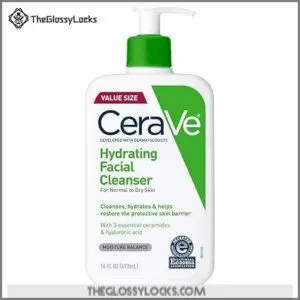
When dry, sensitive skin meets the wrong cleanser, it’s like pouring gasoline on a fire.
CeraVe’s Hydrating Facial Cleanser changes that game completely.
This fragrance-free, non-comedogenic formula delivers 24-hour hydration while gently removing makeup and impurities without the tight, stripped feeling you’d expect.
What makes this gentle cleanser special?
Ceramides Benefits include restoring your skin’s protective barrier, while maintaining ideal pH Balance prevents irritation that triggers redness.
The lotion-like texture requires a simple Application Technique: massage onto damp skin, then rinse with lukewarm water.
Hydration Levels stay consistent throughout the day, making it perfect for your skin care routine.
Gentle Ingredients earned it certification from the National Eczema Association.
Best For: Anyone with sensitive skin seeking effective cleansing without compromising their skin’s natural moisture barrier.
2. Fragrance Free Dove Beauty Bar Soap

Looking beyond basic cleansers, Fragrance Free Dove Beauty Bar Soap offers gentle cleansing without the harshness that triggers redness.
This isn’t your typical drying soap – it’s formulated with moisturizing cream that actually supports your skin barrier while cleaning.
Here’s why it works for sensitive skin:
- No sulfates or fragrances that commonly irritate redness-prone skin
- Hypoallergenic formula reduces risk of allergic reactions
- Moisturizing ingredients prevent the tight, stripped feeling that worsens redness
You can use this versatile redness reducer as a gentle cleanser for face, hands, or body.
It’s cruelty-free and won’t disrupt your skin care routine’s delicate balance.
Many users find it’s the perfect starting point for building a redness-fighting regimen – think of it as your skin’s security blanket in soap form.
Best For: Daily gentle cleansing without irritation or barrier damage.
3. Vanicream Sensitive Skin Moisturizer
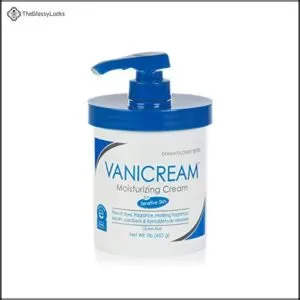
Your skin’s sensitivity deserves the gentlest touch, and Vanicream Sensitive Skin Moisturizer delivers exactly that.
This fragrance-free powerhouse packs serious Vanicream Benefits without the drama—no comedogenic ingredients, no harsh additives, just pure hydration. The moisturizer ingredients work overtime to strengthen your skin barrier while calming redness.
Application tips? Start small on damp skin for maximum absorption. User reviews consistently praise its gentle formula for sensitive skin types.
This dermatologist-tested cream earned the National Eczema Association’s Seal of Acceptance, making it a trusted ally in your skin care routine against stubborn redness and irritation.
Best For: Sensitive skin seeking fragrance-free, non-comedogenic moisturizers that provide deep hydration without irritation.
4. Avne Antirougeurs Soothing Face Mask
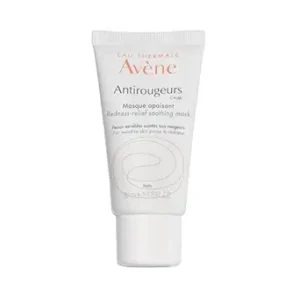
When your moisturizer isn’t cutting it, Avène Antirougeurs Soothing Face Mask steps in as your redness relief hero.
This mask ingredients powerhouse contains thermal spring water and anti-inflammatory compounds that provide immediate skin calming benefits.
Its unique application technique allows dual use—apply as an overnight treatment or 10-minute rescue mask for instant redness soothe effects.
The formula delivers exceptional skin hydration while targeting visible blood vessels and irritation.
User experiences consistently praise its gentle yet effective approach to managing flare-ups.
This redness reducer won’t clog pores, making it perfect for sensitive skin types struggling with reactive episodes.
Best For: Those with sensitive, rosacea-prone skin seeking reliable skin care routine additions.
5. No7 Cica Rescue Skin Paste
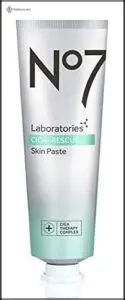
Ever wish you could hit “undo” on your redness? No7 Cica Rescue Skin Paste might just be your new secret weapon.
This redness reducer is packed with skin-calming Cica, making it a star for sensitive skin, rosacea, and those stubborn micro red spider veins. The texture is creamy but sinks in fast—no sticky mess, just comfort.
Use it in your skin care routine day and night for best results. People rave about its Redness Relief Efficacy, and the No7 Ingredients Analysis shows gentle, soothing components.
If you’re after Cica Paste Benefits, this paste delivers. Want alternatives? There are other Cica products, but this one shines for texture and results.
6. Colorescience Redness Corrector with SPF
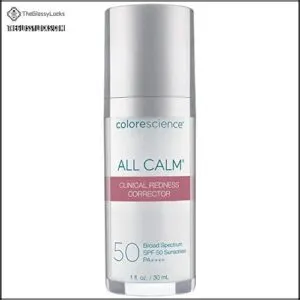
When your skin’s throwing a redness tantrum, Colorescience Redness Corrector with SPF steps in like a superhero.
This color-correcting product uses green undertones for redness reduction while delivering mineral SPF 50 protection. The ingredient analysis reveals niacinamide in its BioSolace complex, perfect for calming irritated skin redness.
SPF benefits include broad-spectrum sunscreen coverage without harsh chemicals. The lightweight texture & coverage works beautifully alone or under makeup.
For application tips, smooth it on after cleansing but before moisturizer. This dual-action formula provides redness control while shielding your face from future damage.
Best For: Sensitive skin needing gentle redness reduction with reliable sun protection.
7. EltaMD UV Clear Face Sunscreen
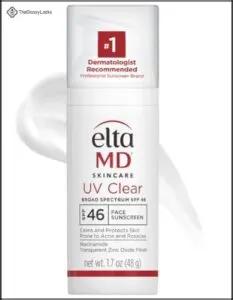
Here’s your number seven pick for reducing redness: EltaMD UV Clear Face Sunscreen. Think of it as your skin’s bodyguard with benefits. This lightweight, oil-free formula packs transparent zinc oxide, niacinamide, and hyaluronic acid into one clear formula that won’t leave you looking ghostly.
The EltaMD benefits include UV protection while calming irritated skin – perfect for your skin care routine. It’s fragrance-free, paraben-free, and non-comedogenic, making it ideal sunscreen for redness management.
Whether you’re dealing with rosacea or general sensitive skin, this broadspectrum sunscreen delivers serious protection without the heavy feel.
Best For: Sensitive skin prone to acne, rosacea, and hyperpigmentation.
8. Jan Marini RosaLieve Redness Reducer
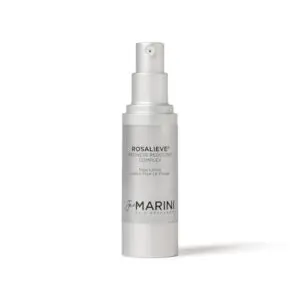
Moving from sunscreen protection, let’s explore another powerhouse for tackling stubborn skin redness. Jan Marini RosaLieve combines potent RosaLieve ingredients like azelaic acid and tetrapeptide-14 to deliver impressive product efficacy.
While the cost analysis reveals it’s pricier than drugstore options, user experiences consistently praise its skin redness reduction abilities. Many calming serums include chamomile to soothe irritated skin.
Here’s what makes this skin care for redness standout:
- Advanced formula targets inflammation at multiple levels
- Clinical-grade ingredients provide professional-strength results
- Gentle application techniques work for sensitive skin types
- Proven track record among dermatologists and users alike
This isn’t your average skin care routine addition—it’s a targeted treatment that addresses skin redness with science-backed skin care ingredients for lasting results.
9. Paula’s Choice Azelaic Acid Booster
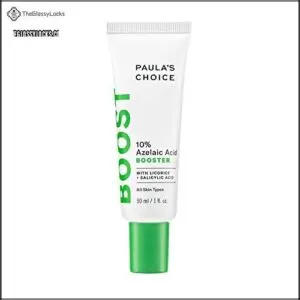
When you’re battling stubborn redness and uneven skin tone, Paula’s Choice Azelaic Acid Booster becomes your secret weapon.
This lightweight, oil-free formula delivers powerful azelaic benefits through its star ingredient—20% azelaic acid—which tackles inflammation while gently exfoliating.
The silky product texture absorbs quickly without greasiness, making it perfect for sensitive skin that can’t handle harsh treatments.
For redness reduction, mix a few drops with your moisturizer or apply directly to problem areas.
This versatile redness solution fits seamlessly into any skin care routine, targeting skin redness while improving overall complexion.
Remember your sunscreen—azelaic acid increases photosensitivity.
Best For: Those seeking gentle yet effective skin care ingredients for persistent redness and hyperpigmentation.
10. Melatonin Night Serum Anti Aging
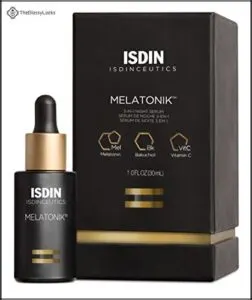
After exploring azelaic acid’s gentle yet effective approach, Melatonin Night Serum Anti-Aging offers another powerful solution for your skin care routine.
This innovative serum harnesses melatonin benefits alongside bakuchiol and vitamin C for thorough redness reduction.
The nighttime application works while you sleep, delivering:
- Antioxidant protection that repairs daily damage
- Anti-aging effects that smooth and brighten skin
- Overnight hydration that strengthens your skin barrier
This serum formulation transforms dull, irritated skin into a radiant complexion by morning.
The melatonin doesn’t just help you sleep better—it actively fights inflammation and supports cellular repair, making it perfect for antiaging goals and redness concerns.
Creating a Personalized Skincare Routine
Creating your perfect anti-redness routine isn’t about following someone else’s ten-step regimen—it’s about understanding what your specific skin actually needs.
You’ll want to start by identifying your triggers and skin type, then build a simple routine that targets your unique redness patterns without overwhelming your already-sensitive skin.
Assessing Skin Type and Needs
Before diving into product selection, you’ll need to play detective with your own skin.
Start by identifying your Skin Type ID – whether you’re dealing with oily, dry, combination, or sensitive skin.
Pay attention to your Sensitivity Levels and Product Allergies that trigger flare-ups.
Consider your Hydration Needs and set clear Routine Goals for your skin care routine.
Understanding these factors helps you choose redness-fighting products that actually work with your skin, not against it.
Customizing a Routine for Optimal Results
After identifying your skin type and triggers, it’s time to build your perfect skin care routine.
Think of ingredient synergy like cooking – some combinations work magic together. Start with patch testing new products and focus on routine sequencing for maximum impact.
Here’s your game plan for customizing success:
- Product layering: Apply thinnest to thickest consistency
- Seasonal adjustments: Switch heavier creams for summer, lighter gels for winter
- Introduce one new soothing ingredient at a time
- Monitor how your skin barrier responds to changes
- Track what reduces inflammation most effectively
Smart routine sequencing means cleansing first, then serums, moisturizers, and sunscreen last.
Your skin will thank you for this thoughtful approach to reducing redness.
Lifestyle Changes for Reducing Redness
While skincare products work wonders on the surface, what you put in your body and how you manage daily stress can make or break your anti-redness efforts.
Simple lifestyle tweaks like eating anti-inflammatory foods and finding your zen can be just as powerful as that expensive serum sitting on your bathroom counter, which can help you achieve your zen.
Maintaining a Balanced Diet
What you eat directly impacts your skin’s appearance and redness levels.
Since you’ve already built your personalized skincare routine, it’s time to fuel your body from within.
Your gut health plays a major role in skin inflammation. When your digestive system isn’t happy, your face often shows it through increased redness and irritation.
Here’s how to eat your way to calmer skin:
- Load up on omega-3s from salmon, walnuts, and flaxseeds to fight inflammatory foods naturally
- Boost nutrient absorption with probiotic-rich yogurt, kefir, and fermented vegetables for better gut health
- Maintain proper hydration levels by drinking water throughout the day—your skin cells need it to function
- Consider dietary supplements like fish oil or vitamin D if your diet lacks anti-inflammatory nutrients
Remember, what goes in your mouth affects what shows on your face.
Managing Stress and Anxiety
Anyone can feel overwhelmed when stress triggers pile up, but managing these emotions is essential for calmer skin.
Deep breathing and mindfulness techniques like meditation help with emotional regulation. Try journaling therapy to process feelings—it’s surprisingly therapeutic!
High cortisol levels from stress can disrupt the skin’s balance.
Stress management isn’t just about mental holistic wellness; reducing anxiety impact through these mindfulness practices genuinely helps your complexion glow.
Protecting Skin From Environmental Factors
Beyond managing stress, your skin faces daily battles with environmental stressors that can trigger redness.
Think of environmental protection as your skin’s personal bodyguard—it’s working 24/7 to keep troublemakers at bay.
Environmental factors like UV radiation and pollution effects create the perfect storm for irritated, red skin.
Here’s your defense strategy:
- Apply mineral-based sunscreen daily to block UV radiation and prevent sun-induced flare-ups
- Use antioxidant serums to neutralize pollution effects and free radical damage
- Focus on barrier strengthening with ceramide-rich moisturizers that lock out irritants
- Choose tinted sunscreen for dual protection—it shields while evening out existing redness
Climate impacts hit differently throughout the year, so adjust your routine accordingly.
Your skin redness sun protection game should adapt to seasonal changes and daily environmental challenges.
Sun Protection and Redness
Sun exposure acts like a magnifying glass on redness, making existing inflammation worse and triggering new flare-ups that can last for days.
The right sunscreen becomes your skin’s best friend, creating a protective barrier that prevents UV rays from turning your face into a tomato, with sunscreen being a crucial element in this process.
Understanding The Impact of Sun Exposure
Sun exposure acts like a magnifying glass on your skin’s redness, turning minor irritation into major flare-ups.
UV rays trigger photosensitivity reactions and worsen existing conditions like rosacea.
Even brief sun exposure without proper skin redness sun protection can cause lasting UV damage.
Your skin remembers every sunburn, making tanning effects counterproductive for managing chronic redness long-term.
Choosing The Right Sunscreen for Redness
When your skin reacts to sunlight like a tomato in summer, choosing the right sunscreen becomes your best defense.
Mineral sunscreens with zinc oxide offer gentle sun protection that won’t trigger flare-ups like chemical sunscreens can.
Tinted sunscreens provide bonus coverage while mineral-based formulas soothe sensitive skin naturally.
Many users find relief from mineral sunscreen redness, which is a common issue with sensitive skin.
Applying Sunscreen Correctly
Getting your sunscreen right isn’t rocket science, but technique matters.
Apply it like you mean it—about a teaspoon for your face alone, spread evenly 15 minutes before heading outdoors.
- Application Amount: Use 1/4 teaspoon for face and neck coverage
- Reapplication Frequency: Every 2 hours, plus after swimming or sweating
- Broad-Spectrum Protection: Choose SPF 30+ with zinc oxide or titanium dioxide
- Daily Sunscreen: Make mineral-based sunscreen your morning ritual, rain or shine
Advanced Treatments for Redness
When your regular skincare routine isn’t enough to calm persistent redness, professional treatments can offer more powerful solutions.
These advanced options range from in-office procedures like laser therapy to prescription medications that target the root causes of chronic inflammation.
Exploring Professional Skincare Options
When your regular routine hits a wall, professional treatments step up your anti-redness game.
Chemical peels and microneedling deliver targeted results that home products can’t match.
These dermatologist-supervised options like laser resurfacing and light therapies tackle stubborn redness at its source.
IPL and pulsed dye lasers specifically target blood vessels causing persistent facial redness.
A dermatologist consult guarantees you’re getting the right laser therapy for your skin’s unique needs.
Understanding Laser and Light Therapy
When choosing laser therapy for persistent redness, you’ll discover several effective laser types and light wavelengths targeting different concerns.
- Pulsed dye lasers selectively heat blood vessels, reducing visible redness
- IPL delivers multiple wavelengths for thorough rosacea treatment
- LED light therapy provides anti-inflammatory benefits with minimal treatment downtime
- Rosacea lasers like Nd:YAG penetrate deeper for severe cases
These light safety-approved treatments offer significant improvement with proper laser selection.
Considering Medical Treatments for Rosacea
Sometimes rosacea calls for reinforcements beyond your daily skincare routine.
Topical medications like metronidazole and ivermectin target inflammation directly, while oral antibiotics tackle stubborn flare-ups from within.
Your dermatologist might recommend prescription creams or even combine treatments with laser therapy for maximum impact.
Think of it as assembling your anti-redness dream team—each treatment plays its part in calming your skin’s rebellion.
Frequently Asked Questions (FAQs)
How to reduce redness in skin care?
Use gentle cleansers, avoid harsh scrubbing, and apply soothing ingredients like niacinamide or centella asiatica. Cool compresses help immediately, while consistent moisturizing strengthens your skin barrier against future flare-ups.
What skincare reduces redness?
Niacinamide, centella asiatica, and azelaic acid work best for calming angry skin. You’ll want gentle cleansers, barrier-repair moisturizers, and products free from fragrances that trigger flare-ups.
What skin treatments reduce redness?
Professional treatments like laser therapy, IPL, and pulsed dye lasers target blood vessels causing redness.
Chemical peels, LED light therapy, and prescription creams with metronidazole effectively calm inflammation and reduce persistent facial redness.
How do you fade redness on skin?
Red skin driving you absolutely crazy? You’re not alone! Gentle cleansers, niacinamide serums, and cool compresses work wonders. Avoid harsh scrubs and fragrances like the plague – they’ll make things worse.
What is the best skin procedure for redness?
Laser therapy’s your gold standard for tackling stubborn redness.
IPL and pulsed dye lasers target those pesky blood vessels directly, offering permanent results with minimal downtime—it’s like hitting the reset button on your complexion.
How long does it take to see results?
You’ll typically notice improvement within 4-6 weeks with consistent skincare changes, though some treatments like laser therapy show results after 2-3 sessions spaced weeks apart.
Can diet affect skin redness?
You are what you eat, so spicy foods, alcohol, and inflammatory ingredients can trigger facial flushing. Your diet directly impacts skin health—reducing trigger foods helps calm redness naturally.
Are there any natural remedies for skin redness?
You can try cool compresses to constrict blood vessels and reduce inflammation. Green tea masks, aloe vera gel, and oatmeal paste also soothe irritated skin naturally, though results vary.
Is skin redness a sign of underlying health issues?
Skin redness can signal underlying issues like rosacea, eczema, or autoimmune conditions, but it’s often just irritation from triggers like sun, stress, or skincare products—not necessarily serious health problems.
Can makeup help conceal persistent skin redness?
Yes, makeup can effectively conceal persistent redness.
Color-correcting green primers neutralize red tones, while tinted moisturizers with SPF provide coverage and sun protection.
These products work like magic to even your complexion.
Conclusion
Remember when your grandmother said "patience is a virtue"? She wasn’t kidding, especially in regards to your skin care routine for reducing redness.
You’ve learned the fundamentals—gentle cleansing, barrier-repairing moisturizers, and religious sunscreen use. But here’s the truth: consistency beats perfection every time.
Your skin won’t transform overnight, but stick with these expert-approved strategies for 4-6 weeks, and you’ll notice calmer, happier skin staring back at you in the mirror, which is a result of patience.
- https://www.rosacea.org/press/2018/july/new-study-finds-415-million-people-may-suffer-from-rosacea-worldwide
- https://us.drsambunting.com/collections/redness
- https://drderme.com/skincare-routine-causing-redness-top-tips/
- https://kimgalloesthetics.com/blog/calm-irritated-skin
- https://www.aad.org/public/diseases/rosacea/triggers/tips

